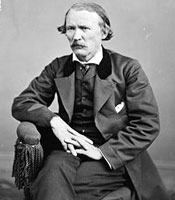(1809-1868)

Kit Carson was a trapper, scout, Indian agent, soldier and authentic legend of the West.
He was born on Christmas eve in 1809 and spent most of his early childhood in Boone’s Lick, Missouri. His father died when he was only nine years old, and the need to work prevented Kit from ever receiving an education. At age 14, he was apprenticed to a saddle maker and he left home for Santa Fe, New Mexico in 1826.
From about 1828 to 1831, Carson used Taos, New Mexico, as a base camp for fur-trapping expeditions that often took him as far West as California. In the later 1830s his trapping took him up the Rocky Mountains and throughout the West. Then, in the early 1840s for a short time, he was employed by William Bent as a hunter at Bent’s Fort.
Carson became integrated into the Indian world as was the case with many white trappers. He traveled and lived extensively among Indians, and his first two wives were Arapahoe and Cheyenne women. Carson was evidently unusual among trappers because of his temperate lifestyle. According to one acquaintance, he was “clean as a hound’s tooth” and a man whose “word was as sure as the sun comin’ up”. He was noted for an unassuming manner and implacable courage.
In 1842, while returning to Missouri to visit his family, Carson happened to meet John C. Fremont, who hired him as a guide. Over the next several years, Carson guided Fremont to Oregon and California, and through much of the Central Rocky Mountains and the Great Basin. Their expeditions and Kit Carson’s rugged mountain man demeanor were celebrated in Fremont’s widely read reports which quickly made Carson a national hero.
Carson’s fame grew as he became associated with several key events in the westward expansion of the United States. He was still serving as Fremont’s guide when Fremont joined California’s short-lived Bear Flag rebellion just before the outbreak of the Mexican-American War in 1846. It was Carson who led the forces of U.S. General Stephen Kearney from New Mexico into California when a band led by Andrés Pico mounted a challenge to American occupation of Los Angeles later that year.
At the end of the war, Carson returned to New Mexico and took up ranching. By 1853, he and his partner were made rich selling sheep in California, where gold rush prices paid them a handsome profit. This same year Carson was appointed federal Indian agent for Northern New Mexico. He held this post until the Civil War imposed new duties on him in 1861.
He played a memorable role in the Civil War in New Mexico. He helped organize the New Mexico volunteer infantry which saw action at Valverde in 1862. Most of his military actions, however, were directed against the Navajo Indians, many of whom had refused to be confined to a distant reservation set up by the federal government.
Starting in 1863 Carson waged a vicious economic war against the Navajo. He marching through the heart of their territory destroying crops, orchards and livestock. When Utes, Pueblos, Hopis and Zunis, who for centuries had been prey to Navajo raiders, took advantage of their traditional enemy’s weakness by following the Americans onto the warpath, the Navajo were unable to defend themselves. In 1864 most surrendered to Carson, who forced nearly 8,000 Navajo to take what came to be called the “Long Walk” of 300 miles from Arizona to Fort Sumner, New Mexico, where they remained in disease-ridden confinement until 1868.
After the Civil War, Carson moved to Colorado in the hopes of expanding his ranch business. He died there in 1868. The following year his remains were moved to a small cemetery near his old home in Taos





